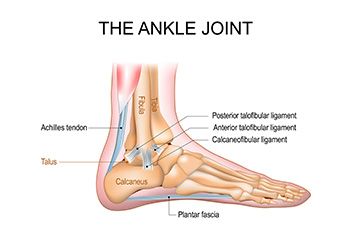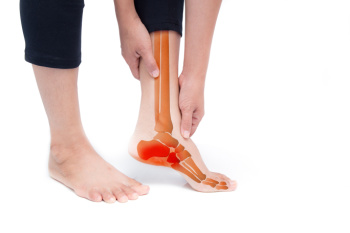Blog

Ankle instability occurs when the ligaments that support the ankle become stretched or torn, leaving the joint vulnerable to repeated sprains. This condition is commonly seen after multiple ankle injuries, and patients often describe their ankle as rolling inward or feeling as if it may give way. True ankle instability results from weakened ligaments. However, functional instability refers to pain or altered mechanics that create the sensation of looseness, even if the ligaments remain stable. Both forms can cause discomfort on the outside or inside of the ankle due to strain on tendons or irritation from altered joint motion. Risk factors include prior ankle sprains, and participation in sports that demand quick changes in direction. A podiatrist can evaluate the extent of instability, identify whether the problem is structural or functional, and recommend treatment. If you experience the feeling that your ankle is giving way, it is suggested that you schedule an appointment with a podiatrist for an accurate diagnosis and appropriate treatment.
Ankle pain can have many different causes and the pain may potentially be serious. If you have ankle pain, consult with One of our podiatrists from Mitchell Foot & Ankle. Our doctors will assess your condition and provide you with quality foot and ankle treatment.
Ankle pain is any condition that causes pain in the ankle. Due to the fact that the ankle consists of tendons, muscles, bones, and ligaments, ankle pain can come from a number of different conditions.
Causes
The most common causes of ankle pain include:
- Types of arthritis (rheumatoid, osteoarthritis, and gout)
- Ankle sprains
- Broken ankles
- Achilles tendinitis
- Achilles tendon rupture
- Stress fractures
- Tarsal tunnel syndrome
- Plantar fasciitis
Symptoms
Symptoms of ankle injury vary based upon the condition. Pain may include general pain and discomfort, swelling, aching, redness, bruising, burning or stabbing sensations, and/or loss of sensation.
Diagnosis
Due to the wide variety of potential causes of ankle pain, podiatrists will utilize a number of different methods to properly diagnose ankle pain. This can include asking for personal and family medical histories and of any recent injuries. Further diagnosis may include sensation tests, a physical examination, and potentially x-rays or other imaging tests.
Treatment
Just as the range of causes varies widely, so do treatments. Some more common treatments are rest, ice packs, keeping pressure off the foot, orthotics and braces, medication for inflammation and pain, and surgery.
If you have any questions please feel free to contact our office located in Chicago, IL . We offer the newest diagnostic tools and technology to treat your foot and ankle needs.

Achilles tendon injuries are often linked to a combination of overuse, biomechanics, and lifestyle factors that place stress on the tendon connecting the calf muscles to the heel. Sudden changes in activity, such as increasing running mileage or adding explosive movements like jumps, can strain the tendon. Training on different surfaces or changing footwear may also raise the risk of Achilles tendon injuries. Tight or weak calf muscles, excessive inward rolling of the foot called pronation, or chronic ankle instability can all contribute to tendon damage. People with high-arched feet or a small leg-length difference are more prone to injury because these conditions alter how pressure is distributed across the feet and ankles. A podiatrist can assess the severity of the injury and provide effective treatment, including surgery, when needed. If you have injured your Achilles tendon, it is suggested that you schedule an appointment with a podiatrist for an evaluation and appropriate treatment.
Achilles tendon injuries need immediate attention to avoid future complications. If you have any concerns, contact One of our podiatrists of Mitchell Foot & Ankle. Our doctors can provide the care you need to keep you pain-free and on your feet.
What Is the Achilles Tendon?
The Achilles tendon is a tendon that connects the lower leg muscles and calf to the heel of the foot. It is the strongest tendon in the human body and is essential for making movement possible. Because this tendon is such an integral part of the body, any injuries to it can create immense difficulties and should immediately be presented to a doctor.
What Are the Symptoms of an Achilles Tendon Injury?
There are various types of injuries that can affect the Achilles tendon. The two most common injuries are Achilles tendinitis and ruptures of the tendon.
Achilles Tendinitis Symptoms
- Inflammation
- Dull to severe pain
- Increased blood flow to the tendon
- Thickening of the tendon
Rupture Symptoms
- Extreme pain and swelling in the foot
- Total immobility
Treatment and Prevention
Achilles tendon injuries are diagnosed by a thorough physical evaluation, which can include an MRI. Treatment involves rest, physical therapy, and in some cases, surgery. However, various preventative measures can be taken to avoid these injuries, such as:
- Thorough stretching of the tendon before and after exercise
- Strengthening exercises like calf raises, squats, leg curls, leg extensions, leg raises, lunges, and leg presses
If you have any questions please feel free to contact our office located in Chicago, IL . We offer the newest diagnostic tools and technology to treat your foot and ankle needs.

When the nerves in the feet lose sensation or do not send signals properly, the risk of injury increases. Cuts, blisters, or sores may go unnoticed and can become infected before they are detected. Reduced awareness of temperature can lead to burns from hot surfaces, or frostbite in cold conditions. Balance may be affected, making falls more likely. Over time, untreated injuries and infections can progress to serious tissue damage, sometimes requiring surgical intervention. Chronic pain from nerve damage can also interfere with daily activities, sleep, and overall quality of life. In people with diabetes, these complications are especially concerning, as slower healing can lead to further medical issues. Regular foot checks, wearing protective footwear, and prompt attention to any changes are essential steps in prevention. If you have symptoms of nerve damage, it is suggested that you see a podiatrist for a thorough evaluation and guided advice.
Neuropathy
Neuropathy can be a potentially serious condition, especially if it is left undiagnosed. If you have any concerns that you may be experiencing nerve loss in your feet, consult with One of our podiatrists from Mitchell Foot & Ankle. Our doctors will assess your condition and provide you with quality foot and ankle treatment for neuropathy.
What Is Neuropathy?
Neuropathy is a condition that leads to damage to the nerves in the body. Peripheral neuropathy, or neuropathy that affects your peripheral nervous system, usually occurs in the feet. Neuropathy can be triggered by a number of different causes. Such causes include diabetes, infections, cancers, disorders, and toxic substances.
Symptoms of Neuropathy Include:
- Numbness
- Sensation loss
- Prickling and tingling sensations
- Throbbing, freezing, burning pains
- Muscle weakness
Those with diabetes are at serious risk due to being unable to feel an ulcer on their feet. Diabetics usually also suffer from poor blood circulation. This can lead to the wound not healing, infections occurring, and the limb may have to be amputated.
Treatment
To treat neuropathy in the foot, podiatrists will first diagnose the cause of the neuropathy. Figuring out the underlying cause of the neuropathy will allow the podiatrist to prescribe the best treatment, whether it be caused by diabetes, toxic substance exposure, infection, etc. If the nerve has not died, then it’s possible that sensation may be able to return to the foot.
Pain medication may be issued for pain. Electrical nerve stimulation can be used to stimulate nerves. If the neuropathy is caused from pressure on the nerves, then surgery may be necessary.
If you have any questions, please feel free to contact our office located in Chicago, IL . We offer the newest diagnostic and treatment technologies for all your foot care needs.

